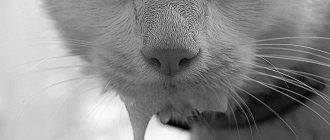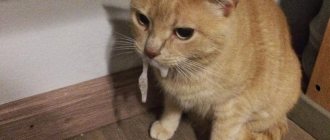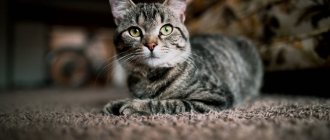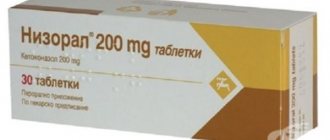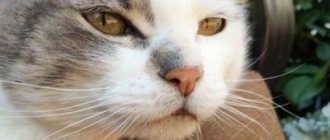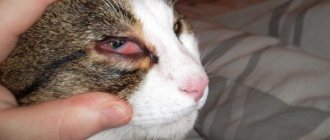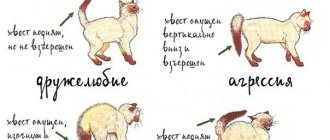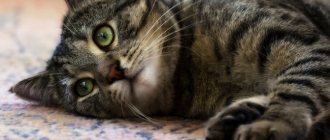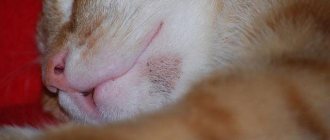Find out about all the possible reasons why your cat is drooling. For each reason there is a different treatment. What needs to be done to prevent this from happening again. Video explanations from veterinarians.
Increased salivation in a cat is a process that has several scientific names: ptyalism, hypersalivation, sialorrhea. The reasons for this phenomenon are also different. Among them there are both absolutely safe ones and those indicating the presence of some kind of pathology. Therefore, it is important to identify the cause in a timely manner in order to provide help to the pet if necessary.
Functions of saliva
Saliva is a secretion that can be watery if it comes from the serous glands, or viscous if it comes from the mucous glands. It contains up to 99.5% water. In addition, the composition includes:
- electrolytes – anions and cations;
- proteins in small quantities;
- mucin
Saliva performs the following functions:
- protects teeth, gums and oral mucosa from damage;
- softens food, makes it easier to chew food;
- extracts flavor elements from food;
- helps the formation of a food coma, which is easier to swallow;
- is able to disinfect and stop bleeding due to the presence of thromboplastic components in the composition.
Bottom line
Cat drooling is a fairly common occurrence, but usually not life-threatening. Often this problem appears due to the curiosity of animals and the inattention of their owners. Contacting a medical specialist will solve all the issues and cope with the problem of excessive salivation.
The cat owner is required to be attentive and take good care of the pet. During the period of illness, the animal suffers, so it needs not only treatment, but also care and love. This costs nothing to a person, but it helps a lot for a sick pet.
Increased salivation in a cat
First of all, let's learn how to examine an animal's oral cavity and highlight some of the main symptoms. And try not to panic prematurely.
There are a number of safe reasons for drooling. This is often normal:
- the animal smelled or saw food;
- during feeding and chewing food;
- many people wonder why a cat drools when you pet it, but it just enjoys it;
- the pet experiences a nervous experience;
- the cat or kitten ate something bitter or was given a tasteless medicine, for example, for worms.
As a rule, in such cases, the volume of discharge in a healthy cat only slightly increases. It can be seen in the fur around the mouth. Don't worry if this process does not take more than 10-15 minutes. Otherwise, measures must be taken.
Tips for keeping your pet safe
A few tips will help you avoid the problem of abnormal salivation and related ailments. Compliance with them allows you to normalize the production of saliva in the animal:
- all drugs and products hazardous to the cat’s health must be kept out of her reach;
- after the problem manifests itself, you need to give your pet more fluid to avoid dehydration and normalize metabolism;
- new food should be introduced into the diet gradually, starting exclusively with liquid food;
- measures should be taken to alleviate the animal’s condition and eliminate relapses by carefully monitoring the cat’s menu;
- the animal does not need to be given bony fish and other food with small hard pieces;
- if damage is detected in the oral cavity, they should be promptly treated with disinfectant compounds;
- When treating fur from ticks and fleas, you need to put a bandage on the cat's neck that will prevent her from licking the drug.
If the doctor’s recommendations are followed and after all the measures salivation returns to normal, then the pet is on the mend. In the future, you need to try to eliminate situations that will harm the cat’s health.
What diseases cause cats to drool?
Drooling or salivation may indicate certain diseases in your pet.
If your cat's teeth are drooling and falling out, periodontal disease and associated gingivitis (bad odor) and dysphagia (difficulty eating) may be the cause. X-ray examination may be required to determine the characteristics and extent of the disease.
The animal often rubs its mouth with its paw. These are signs of stomatitis and (or) gingivitis. In this case, the most profuse salivation is possible. Treatment consists of taking antibiotics and anti-inflammatory drugs. In exceptional cases, tooth extraction will be required.
If the tongue sticks out and drools heavily, this may indicate a broken tooth with damage to the nerve endings, or damage to the temporomandibular joint, as well as be a manifestation of some other injuries.
Malocclusion. May occur in the presence of tumors in the oral cavity. Cancerous tumors in this area are a common cause of drooling in older cats.
When a cat drools while sleeping, it could be a sign of uremia (kidney failure), a common disease most common in older animals. A sure symptom of the disease is bad breath.
There are also several other reasons. For example, frequent nausea may indicate the presence of serious liver disease. If the liver does not work properly, toxins accumulate in the animal's blood. Nausea and accompanying drooling are the first clinical signs of liver disease.
However, do not forget that a number of other diseases also cause nausea. Do not try to cure your pet yourself. Only specialists from a veterinary clinic can conduct a full diagnosis and prescribe comprehensive treatment.
Diagnostics
There are many different causes of excessive salivation. You will need to provide a detailed health history of your cat, including vaccination status, current medications, possible exposure to toxins, background history of symptoms, and any other possible incidents that may have triggered the condition.
Your doctor will need to differentiate hypersalivation associated with a condition that causes difficulty swallowing from hypersalivation associated with nausea by looking for signs such as depression, slurping lips, and vomiting.
Your doctor will also want to conduct a complete physical and neurological examination of your cat, paying special attention to the mouth and neck.
Diagnostic tools may include x-rays and ultrasound to determine if there is a problem in the structure of the liver, or in any other internal organs.
If an immune-related disease is suspected, your veterinarian may also want to perform a tissue and cell biopsy.
Symptoms and signs
Heavy salivation in a cat can be accompanied by various physiological changes. They are not difficult to spot.
- The cat does not eat anything and is drooling. This happens with gastrointestinal diseases or viral diseases. At the same time, if you notice that your pet refuses to eat, but is drooling profusely, you should not leave everything to chance and it is better to contact a veterinarian.
- The cat stopped taking solid food, which he used to eat with great desire. This may indicate problems with the mouth, teeth, or digestive system. Also, hard pieces of food may fall out of the mouth, and the animal holds its head in an unusual position.
- Changes in cat behavior. Just like us, cats experience some discomfort when they are sick. This may affect behavior - increased aggressiveness or irritability is noticeable.
- The cat's eyes water and drool, she has difficulty swallowing food, she feels nauseous and vomits - symptoms associated with drooling that indicate digestive problems.
- The cat is drooling and has bad breath. If there are any problems in the oral cavity, the pet begins to frequently rub its face.
So, we have determined why the cat is drooling. We also figured out what accompanying symptoms may indicate health problems. Now it's time to understand what to do if your cat is drooling.
Causes of excessive salivation
Before treating your pet, you should figure out why the cat is drooling, in other words, find the irritant and find out why this is happening. The reasons why a cat has drooping salivation can be very different - ranging from any damage in the oral cavity or digestive tract to viral diseases .
- Most often this occurs due to the accumulation of hair in the stomach. Cats are very clean animals, they take care of themselves and groom themselves often.
- Already during licking, more saliva may be released than usual, and along with it, fur enters the esophagus, and over time, a lump of quite impressive size may form. What does drool have to do with it? It's simple - you need to burp it up, and it's difficult to do this without additional saliva.
- The next most popular cause is poisoning. If you know your cat well, then you should know that they love to eat what they “caught”. Unfortunately, their “trophies” are not always healthy or safe, and often cause excessive salivation.
- Cats often drool when they have allergies. If for some reason you decide to change your pet’s food, and during adaptation there is a large amount of saliva, nausea or vomiting - these are signs of allergy or poisoning.
- A foreign body in the throat or esophagus can also cause a large amount of saliva to be produced.
- If a cat has any mechanical damage in the oral cavity, there are also neoplasms or ulcers, wounded cheeks or lips, sore teeth or damaged enamel.
- Viral and oncological diseases.
One of the worst causes of excessive salivation is rabies. Hypersalivation is a symptom of this disease. In addition, the animal may be afraid of light, be aggressive or, on the contrary, overly affectionate, appetite changes, etc. Rabies is incurable, but it is quite difficult for a cat living in an apartment to catch it, especially since today they are regularly vaccinated to prevent the development of this disease.
© shutterstock
What to do if your cat is salivating excessively
If you notice that your cat is drooling a lot, you should immediately call a veterinarian for help. Only a doctor can make an accurate diagnosis. He examines the animal, assesses the nature of salivation, determines its causes and prescribes treatment on this basis. There is no point in doing this on your own; it will only make things worse.
A professional knows how to examine the animal completely, including the oral cavity, without unnecessary discomfort for the animal. In this case, the doctor correctly determines the cause of increased salivation. At home, it is extremely difficult to remove a foreign object if it gets into the esophagus or pharynx. And the doctor will do this quickly and accurately.
When an animal is diagnosed with a disease, the veterinarian prescribes medications and gives useful recommendations to the owners on how to proceed. This helps to cure your pet as quickly as possible.
Drooling in cats is quite common. Fortunately, its causes are rarely associated with danger to the life of pets. But if problems are detected, it is better to consult a doctor immediately.
Original publication: Why Is My Cat Drooling? Author: Arnold Plotnick, DVM
Stress
Placing your pet in a carrier or driving him to the veterinarian may cause his salivation to increase. If the pet is angry, such a reaction is also possible. Cats are not fans of sudden changes. A sudden change of environment can seriously alarm the animal. In such a situation, the salivary glands begin to work hard. In order for your pet to return to normal, you need to return it to its familiar territory as soon as possible. Or simply leave it in a quiet and peaceful place where no one will disturb him for a while.
Treatment of epilepsy
Treatment is a long and complex process. Even with the correct selection of medications and the complete absence of any manifestations for a long time, doctors only talk about stable remission, but not about complete elimination of the disease. The basis of therapy is medications:
- anticonvulsants (phenobarbital, clonazepam, lamotrigine, depakine and others): taken continuously to prevent seizures;
- tranquilizers (phenazepam, diazepam): eliminate anxiety and relax the body;
- neuroleptics (aminazine): reduce the excitability of the nervous system;
- nootropics (piracetam, mexidol, picamilon): improve metabolism in the brain, stimulate blood circulation, etc.;
- Diuretics (furosemide): used immediately after a seizure to relieve swelling in the brain.
If necessary, the doctor may prescribe other groups of drugs.
If medications are not effective enough, doctors may resort to surgery. The choice of a specific operation depends on the location of the pathological focus and the form of the disease:
- removal of a pathological formation (tumor, hematoma, abscess) that caused the attacks;
- lobectomy: excision of the area of the brain in which the epileptogenic focus occurs, usually the temporal lobe;
- multiple subpial transsection: used when the lesion is large or cannot be removed; the doctor makes small incisions in the brain tissue that stop the spread of excitation;
- callosotomy: dissection of the corpus callosum, which connects both hemispheres of the brain; used for extremely severe forms of the disease;
- hemispherotopia, hemispherectomy: removal of half of the cerebral cortex; the intervention is used extremely rarely and only in children under 13 years of age due to the significant potential for recovery;
- installation of a vagus nerve stimulator: the device constantly stimulates the vagus nerve, which has a calming effect on the nervous system and the entire body.
If indicated, osteopathy, acupuncture and herbal medicine can be used, but only as a supplement to the main treatment.
Make an appointment
Diagnosis
The cat must be shown to a veterinarian if you cannot independently determine the cause of hypersalivation. The doctor will examine your pet's mouth to rule out or confirm the presence of inflammation in the mouth. If they are not there, you will have to examine the animal more carefully.
The clinic will conduct the following studies:
- A general analysis of blood, urine, and feces for worm eggs.
- If trichobezoars are suspected, an x-ray or ultrasound of the peritoneal organs will be performed. These studies can also help identify neoplasms.
Prevention
Preventive measures for excessive salivation in cats include the following:
- Regular cleaning of the oral cavity, including teeth and tongue.
- Apply flea treatment to areas that the cat cannot reach. A protective collar can be used.
- Quarterly deworming.
- Timely vaccination against rabies and other viral diseases.
- Providing adequate nutrition. The food should not contain bones.
- Storing medications, household chemicals, and toxic substances in places inaccessible to animals.
- Limiting your pet's access to indoor plants.
To prevent food poisoning, keep the trash can closed. Do not give your cat food from the table, especially sweets, pickles or smoked meats. It is necessary to regularly bring the animal to the veterinary clinic for periodic examinations. Timely preventive measures will prevent your pet from getting sick.
Esophageal carcinoma
In very serious cases, untreated gastroesophageal reflux disease (and subsequent Barrett's esophagus) can lead to esophageal cancer. The main risk factors are alcohol consumption, smoking, poor nutrition, and chronic esophageal diseases with reflux.
Symptoms include weight loss, trouble swallowing, or gastrointestinal bleeding. This is something that happens over decades of untreated reflux (30-40 years), so those who are 30 and otherwise healthy have no reason to suspect cancer. But if you're over 50 and have had heartburn for years and suddenly lose weight, for example, this is definitely what your doctor will suspect first.
Composition and properties of saliva
Cat saliva is a viscous liquid that is 99% water and 1% dry matter. When magnified multiple times, it reveals:
- mucous membrane particles;
- leukocytes;
- leftovers;
- microbes and bacteria.
Cat saliva also contains organic (mucoproteins), inorganic substances and metabolic products. Mucin is a special type of protein. It seems to bind food particles together. Thanks to this, food is easy to swallow.
Inorganic substances include:
- calcium;
- potassium;
- magnesium;
- sodium;
- sulfates;
- chlorides.
Cat saliva contains metabolic products and enzymes - ptyalin, maltase. They are involved in the breakdown of food and are activated only in slightly alkaline environments at temperatures between 38-40 degrees.
Cat saliva performs many useful functions:
- Maintains correct acid-base balance.
- Neutralizes the aggressive effects of gastric acid.
- Reduces the toxicity of caustic substances.
- Protects against mechanical damage and disinfects the oral cavity.
- Participates in thermoregulation - thanks to saliva, cats shed excess heat.
